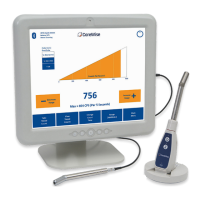Intended Use
The C-Trak
®
Apollo system (CW4000) is the new iteration of the existing Galaxy CW4000 device; an active, invasive medical device comprised
of a pre-compliant Panel PC incorporating an analyser MCA, power supply, Wireless accessory, gamma probe (Omniprobe), and probe cable
(either USB where specified or coaxial signal cable, depending on the chosen use mode).
The device and wireless accessory have a defined lifetime of Seven years. There are no safety implications of using the device or any
accessory after this period as long as the device is in good condition and the performance checks stated in the manual are performed as
required prior to use.
The gamma probe (Omniprobe) works using scintillation technology which converts radiation counts into an electronic signal which is then
processed by proprietary Apollo software. The software provides feedback to the user about how much radiation is being detected from a
source; feedback is numerical, graphical, and audible.
The basic intent of the Apollo system is to provide the user with feedback about the location of sources of radiation in an intraoperative
environment. This information is used by surgeons to indirectly locate various tissues of interest, e.g. tumours or lymph nodes that might
harbour metastatic disease.
The user is either a surgeon trained in the diagnosis, search for, and removal of various forms of cancerous tissues or tissues of clinical interest,
or a nuclear medicine physician experienced with the use of radiolabelled agents used to localise tissues of clinical interest. The surgeon is
supported by trained operating room nurses, who assist the surgeon in the use of the system, under the surgeon’s supervision. The patient has
no direct influence over the use of the device and the system itself does not perform any diagnostic function.
In normal use, the operator of the CW4000 views the product from the front, facing the computer screen usually at a distance no greater
than nine (9) feet. The ID/Serial Number Label is on the rear of the product (computer) and is intended to be viewed in a normal, room
lighting environment (500 lx or greater) by a person with a visual acuity (corrected, if necessary) of 20/20 at a distance of approximately
12-18 inches (a normal reading distance). Aside from the serial number, the information included on this label is also available in the printed
User’s Guide (included with each product) and the on-screen User’s Guide.
Product operation follows the basic guidelines as outlined in the NEMA NU 3, Performance Measurements and Quality Control Guidelines for
Non-Imaging Intraoperative Gamma Probes.
The Apollo system and accessories are non-sterile devices that are to always be used inside a sterile sheath or similar appropriate sterile
barrier system. There are provisions for reprocessing and sterilising the device described in Section 5.
The Intended application for this system is to locate tissues of clinical interest in Sentinel Lymph Node Biopsies (SLNB procedures) for various
cancer types, parathyroid procedures and, tumour localisation.
There are no limitations to the Intended population the device may be used on with regards to age or patients with pre-existing conditions.
The only factor that should be considered is the size and selection of probe that best suits the site of the intended procedure (i.e. use of a
slimmer collimator where required).
The Apollo system may also be used for the localisation of I-125 seeds.
The system is NOT to be used on the following:
• Central Nervous System (CNS): the Brain, Meninges and Spinal Cord.
• Central Circulatory System, meaning the following blood vessels: arteriae pulmonales, aorta ascendens, arcus aortae, aorta descendens
to the bifurcatio aortae, arteriae coronariae, arteria carotis communis, arteria carotis externa, arteria carotis interna, arteriae cerebrales,
truncus brachiocephalicus, venae cordis, venae pulmonales, vena cava superior and vena cava inferior.
43
Appendix H

